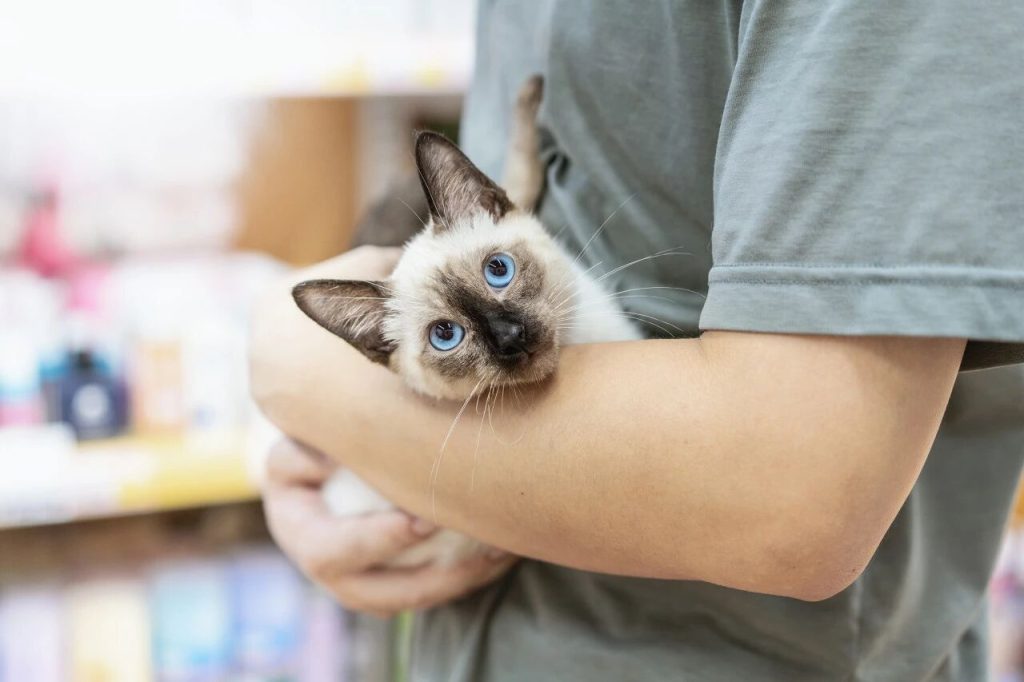You’ve probably come across those adorable little kittens with black faces, black ears, and black tails online. Their slim limbs and gentle personalities are paired with a soft creamy-white coat, but their faces are dark and striking. With bright, round blue eyes, they look extra cute and clever against their dark little faces, making them reminiscent of the little black coal-like creature from Spirited Away. You might think this is how they’ve always looked, until one day, you stumble upon an old video from three years ago, posted by the same blogger: the newborn Siamese cat was almost pure white, with only a small patch of black on its face. Its ears and tail were just a faint shade of light brown. How strange—could this really be the same cat? How did it turn black over time, and can it turn back to white?
-
Enzyme Mutation: Whitening, but Not Completely White
So, what exactly causes Siamese cats to “change color” based on temperature? The answer lies in a genetic mutation affecting the enzymes involved in melanin production. Specifically, a key enzyme responsible for this process, tyrosinase, is mutated in Siamese cats. Tyrosinase is crucial for catalyzing the production of dopaminequinone, a precursor for melanin. The enzyme’s activity level determines whether melanin is properly deposited.When the process is abnormal, it results in a condition called albinism. However, the severity and type of albinism can vary greatly. Some cats are completely albino with no pigment at all, while others, like Siamese cats, experience partial albinism. This partial condition is known as “extremity albinism” or “pointed coloration.” In this case, the mutated tyrosinase enzyme changes melanin deposition based on temperature. In cooler areas of the body, such as the ears, paws, tail, and nose, where the temperature is lower, tyrosinase remains active, causing pigment to be deposited. In warmer areas, such as the torso, there’s little to no pigment, which explains why Siamese cats have darkened extremities and a lighter body.Interestingly, the color change seen in Siamese cats is actually a “recovery” of the missing pigment. The areas that seem to change from white to dark are simply re-establishing their normal pigment, temporarily correcting what was absent due to the mutation. This temperature-induced pigmentation change is not exclusive to Siamese cats. In addition to Himalayan rabbits, some mice and even dogs with the same gene can experience similar color changes, and this phenomenon has been observed in humans as well. However, Siamese cats are the most well-known example of this, and their color change pattern is often referred to as the “Himalayan pattern” in animals and the “Siamese pattern” in cats.When it comes to cats changing colors, the most famous and representative breed is the Siamese cat. Over a century ago, people noticed that Siamese kittens are almost pure white at birth, but as they grow, their fur gradually darkens. Researchers soon realized that a phenomenon known as “Himalayan rabbits,” whose fur color changes in colder temperatures, could be the key. This led them to wonder: could Siamese cats’ color changes also be linked to temperature?To investigate, researchers conducted three experiments. First, they brought two purebred Siamese cats from Germany to Moscow—at this point, their bodies were a light cream color, and the “pointed” areas—face, ears, limbs, and tail—were nearly black. These cats were kept in a wooden house where temperatures fluctuated between -3°C and 16°C, with the highest temperature reaching no more than 19°C, which coincided with their shedding period (usually when cats stay in warmer rooms). After two and a half months, both Siamese cats’ fur had noticeably darkened, with the fur on their sides and backs growing a light brown or chocolate color. After another two and a half months, they became entirely chocolate-colored, with the “pointed” areas even darker and their hindquarters and shoulders turning deep brown.In the second experiment, the researchers removed a bald patch from the cats’ shoulders, about the size of a ping-pong ball, and covered it with cotton to maintain the area at a temperature of 34.5°C to 36°C. After six weeks, the new fur that grew back in that area had chocolate-colored tips and white or even colorless bases, forming a visible circular gradient.The third experiment used chemical agents to locally cause blood flow to the cats’ ears and forelegs, and as a result, new fur grew with white or even colorless tips. These three experiments demonstrated that in cold temperatures, Siamese cats’ fur pigments are strongly deposited, making their fur darker. In contrast, warmer temperatures result in less pigment deposition, leaving the fur lighter. In the second experiment, the gradual color change occurred because the newly grown fur hadn’t had enough time to “color” due to the warmer environment. Siamese cats are predominantly white at birth because of the higher temperature inside the mother’s womb.Moreover, different areas of the Siamese cat’s body have different temperature thresholds for color change. The back has a lower threshold and can turn white at temperatures around 30-32°C. The shoulders are slightly less sensitive, turning white around 36-37°C, while the ears and limbs are more heat-resistant, requiring temperatures over 43°C to change. Under normal room conditions, the ears and limbs will appear completely black.

-
Not Just Siamese Cats, and Not Only One Mutation
However, it’s important to note that not only Siamese cats experience color changes. There are different types of genetic mutations, and they occur in different regions of the body or result from amino acids being replaced with different ones. As mentioned earlier, Siamese cats have “pointed” regions, with most of their body being white. These cats are highly sensitive to temperature changes, with their fur changing dramatically with only minor environmental shifts, such as shaving or covering them with cotton.On the other hand, Burmese cats can also change color but follow a different pattern. While their extremities do darken like Siamese cats, the transition is more gradual, and the rest of the body remains a more even color, making it less “black and white.” This difference occurs because the genetic mutations in Siamese and Burmese cats are not the same. In Siamese cats, the amino acid glycine is mutated into arginine, while in Burmese cats, it’s mutated into tryptophan. Thus, despite both mutations affecting the C-locus gene (which regulates pigment), the changes lead to two distinct patterns. There are also cats, like the “East African cat,” that show a blend of these two patterns, with traits from both Siamese and Burmese breeds. Additionally, some breeds, like the Siberian and Russian Blue cats, may carry the mutation but do not exhibit the temperature-sensitive color changes.It’s worth noting that achieving a “temperature-changing” kitten isn’t as simple as it seems. The mutation is recessive, meaning a kitten must inherit the mutated gene from both parents to exhibit the color-changing effect. If the kitten inherits a normal gene from one of the parents, it will not exhibit the characteristic color change. While the temperature-dependent color-changing trait in Siamese cats is fascinating, it’s not without drawbacks. The same mutation that affects their coat color can also reduce pigment production in their eyes, often resulting in blue eyes or even a “red-eye” effect, which is another characteristic of the breed.
Although the Siamese cat’s striking blue eyes are as beautiful as the stars, the reduced production of melanin in the retinal pigment epithelium affects the normal development and function of the retina. This can cause visual information to be misaligned when it reaches the brain, leading to a lack of proper depth perception, reduced visual resolution, and blurred vision.But who knows? When a Siamese cat stares at you with those big eyes, it might actually be struggling to see clearly, trying its best to focus. But whether the cat is good or bad, whether its eyes are good or not, whether they’re blue or not—does it really matter?





